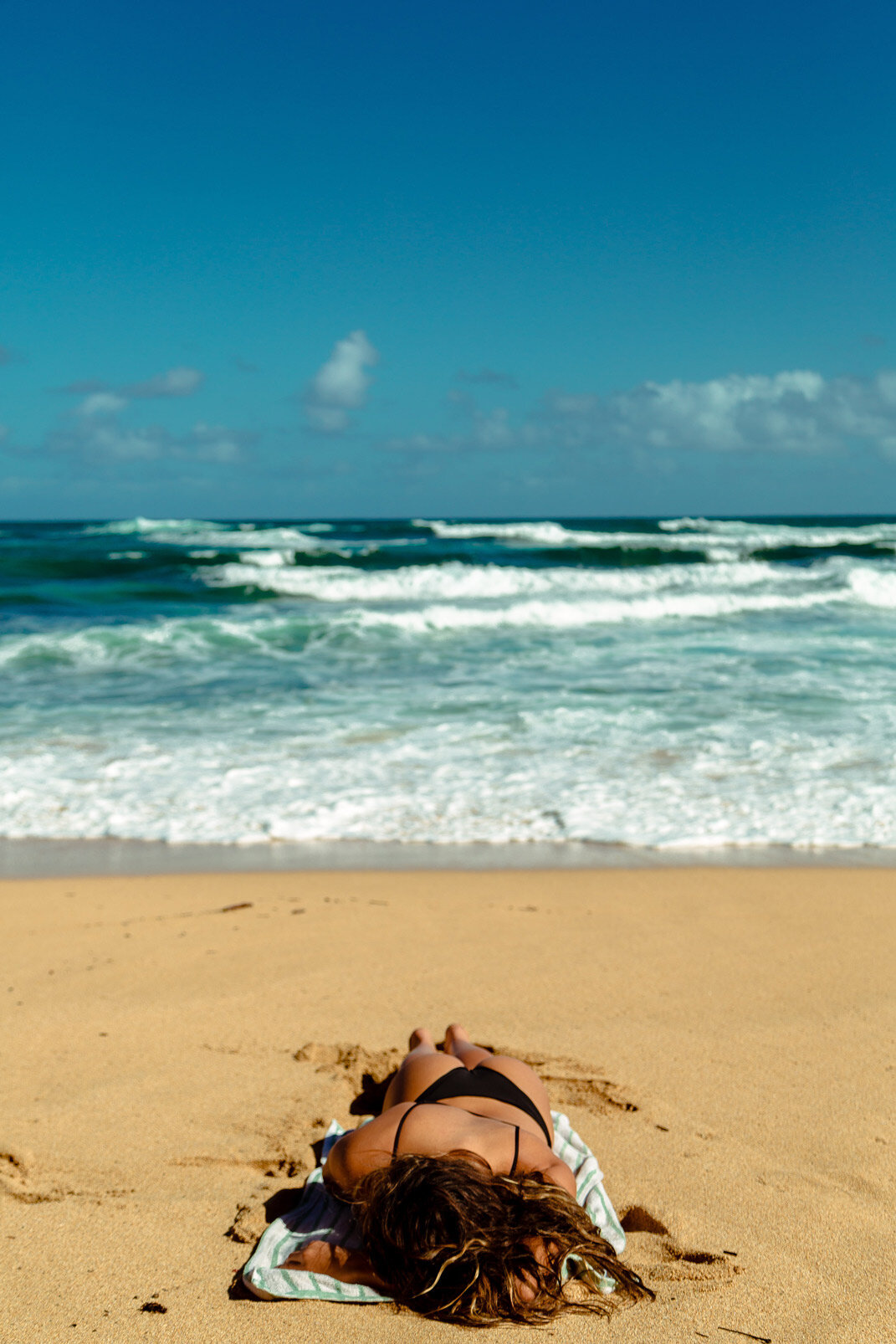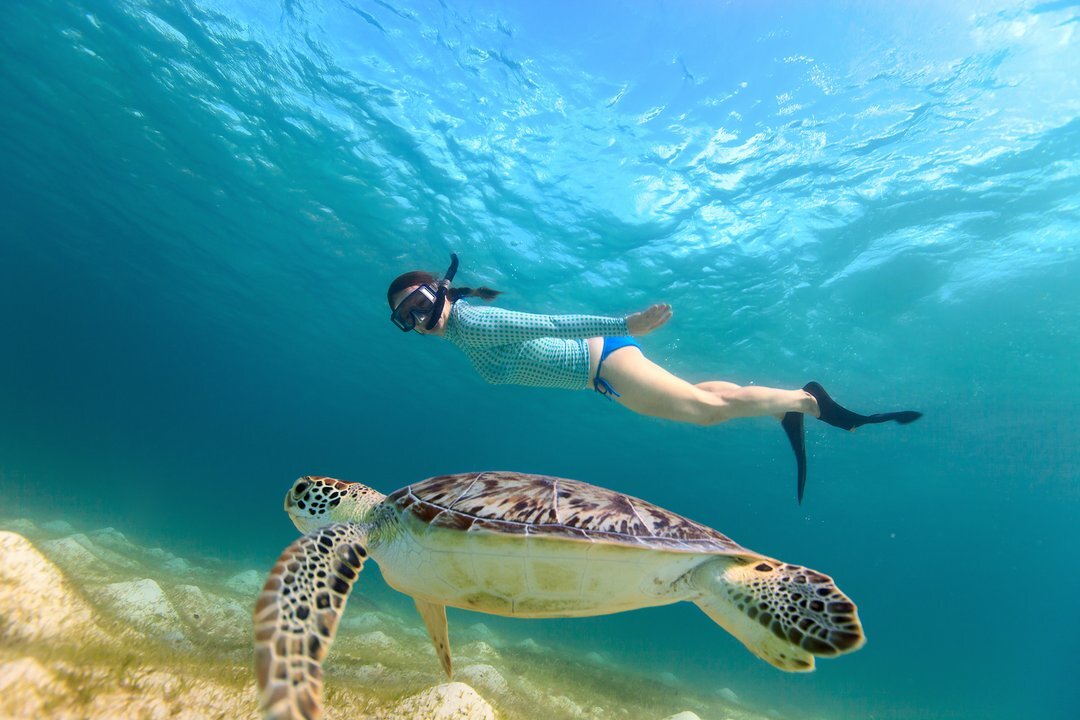Is My Sunscreen Killing the Planet?
According to the National Ocean Service, thousands of every day skin products are threatening marine life and there are a few ways we can help. The diagram below explains perfectly what happens when you mix certain chemicals to the underwater world.
How sunscreen chemicals enter our environment: The sunscreen you apply may not stay on your skin. When we swim or shower, sunscreen may wash off and enter our waterways.
How sunscreen chemicals can affect marine life:
Green Algae: Can impair growth and photosynthesis.
Coral: Accumulates in tissues. Can induce bleaching, damage DNA, deform young, and even kill.
Mussels: Can induce defects in young.
Sea Urchins: Can damage immune and reproductive systems, and deform young.
Fish: Can decrease fertility and reproduction, and cause female characteristics in male fish.
Dolphins: Can accumulate in tissue and be transferred to young.
Chemicals in some sunscreens that can harm marine life include: Oxybenzone, Benzophenone-1, Benzophenone-8, OD-PABA, 4-Methylbenzylidene camphor, 3-Benzylidene camphor, nano-Titanium dioxide, nano-Zinc oxide, Octinoxate, Octocrylene
Here are a few ways to protect ourselves and marine life: Consider sunscreen without chemicals that can harm marine life, seek shade between 10 am & 2 pm, and use Ultraviolet Protection Factor (UPF) sunwear.
I’M ON FIRE.
Whether you prefer indoor UV tanning or relaxing on a Caribbean beach (we suggest St. Maarten, obviously), the chances of developing skin cancer or melanoma are scary high. Melanoma is the most common cancer in the world and will affect 1 in 5 Americans before the age of 70. If you have experienced more than 5 sunburns in your life, you’ve just doubled your risk for melanoma. The good news? When detected early, the 5 year survival rate for melanoma is 99%.
SURVEY SAYS.
72% of Americans think they look better tan.
Yet - according to the American Academy of Dermatology - out of that group, 80% are concerned about skin cancer.
So what do you choose? Going for a darker shade or saving the planet?
What if you had a product that could protect you from those nasty rays, give you a healthy looking glow (without the burn) and be 100% safe for coral reefs and marine life?
YOUR ULTIMATE COVERAGE
This WATERBLOCK™ water-resistant system is clinically formulated for healthy active outdoor living. In fact, SolRX was originally developed for triathletes seeking reef-friendly products that could protect for hours in wet conditions. Every SolRX product is clinically-tested up to and beyond the FDA standards for Sport Sunscreens.
REEF FRIENDLY
SolRX™ was started with the belief that a healthy life includes a healthy amount of time spent outside. That love of the outdoors especially extends to our oceans and lakes. Their commitment to reef friendly products is in their DNA. All of their products meet the guidelines from the Environmental Working Group’s criteria for Sport Sunscreens. (ewg.org). They are 100% Oxybenzone free. In fact, SolRX™ already conforms to the FDA’s next round of protocols for sunscreens. They also proudly support Surfrider Foundation (surfrider.org), Sea Turtle Conservancy (conserveturtles.org) and other ocean related charities.
8 HOURS +++
SolRX WATERBLOCK™ system is water resistant for 8 hours. Independent testing showed WATERBLOCK performed at virtually full SPF-rating throughout the 8 hour test. That testing methodology has now become the industry standard.
-
AIRLINES
- Apr 15, 2021 New Budget Airline Flying to St. Maarten
- Oct 4, 2022 Air Canada - The Worst Airline in the World?
- ANGUILLA
- DIGITAL NOMAD
- DIGITAL NOMAD LIFE
-
EDITORIAL
- Mar 8, 2024 Will Amazon Buy ByteDance’s TikTok?
-
GEAR
- Apr 28, 2023 The Best Webcams For Creating Video Reviews
- May 25, 2023 The Top 3 Best Cameras to Master Youtube
-
GEAR HEAD
- Feb 17, 2021 Must Have 2021 Gear
-
HOTEL REVIEWS
- Feb 16, 2021 Review: Zemi Beach House Hotel & Spa in Anguilla – The New Best Place on Earth?
- Feb 16, 2021 Review: Hotel Monteleone in New Orleans – The Heartbeat of a City
- Feb 16, 2021 The Banks Mansion in Amsterdam – Welcome Home!
- Feb 16, 2021 Little America Hotel in Salt Lake City – The Royal Treatment
-
ONLINE MARKETING
- May 22, 2023 The Power of Copy: Boosting Sales with Compelling Content
- May 25, 2023 Top 10 Online Marketing Books for Success
- May 26, 2023 Top 7 Affiliate Marketing Programs for Passive Income and Early Retirement
- Jun 9, 2023 Unleash Your Inner Influencer: Join the Faceless Product Review Profits Course
- Oct 13, 2023 Unlocking Digital Domains with Ease: Your Gateway to Online Presence!
- Dec 19, 2023 How To Be A Successful Blogger - Our Ultimate Workflow
- Feb 9, 2024 Anguilla's Windfall: How AI's Rise Turned a Tiny Island Paradise into a Domain Powerhouse
- Mar 8, 2024 Will Amazon Buy ByteDance’s TikTok?
- May 8, 2024 Revolutionizing Car Sales: Amazon’s Game-Changing Partnership with Hyundai
- Jul 18, 2024 Score Big with High-Paying Affiliate Programs in 2024!
-
OPINION
- Mar 8, 2024 Will Amazon Buy ByteDance’s TikTok?
-
SHOPPING
- Apr 21, 2021 Organize and Level Up your Home with our Favorite Things
- Jun 26, 2023 Unleashing the Shopping Frenzy: Amazon Prime Day Delights Shoppers and Sellers Alike!
- Jul 31, 2023 Beat the Heat with Style: Introducing the 2023 Upgraded Andobil Car Windshield Sun Shade Umbrella
- Jul 31, 2023 Enjoy Instant Hot Water with Waterdrop's Reverse Osmosis Dispenser System
- Jul 31, 2023 The G4Free RFID Sling Bag Crossbody: Your Stylish & Secure Companion for Life on the Go!
- Jul 31, 2023 Experience the Cosmos at Home: Rossetta Star Projector
- Jul 31, 2023 Travel Smarter and Lighter with Surblue Hanging Travel Shelves Compression Packing Cube!
- Jul 31, 2023 Fanttik X8 APEX Tire Inflator Portable Air Compressor: Your Ultimate On-the-Go Buddy!
- Jul 31, 2023 BLUETTI EB3A - Your Ultimate Portable Power Station
- Jul 31, 2023 Kelamayi 2021 Upgrade Broom and Dustpan Set: Cleaning Made Smarter and Easier!
- Aug 3, 2023 Oladance Open Ear Headphones Bluetooth 5.2 Wireless Earbuds: A Symphony of Style and Innovation
- Aug 3, 2023 Unleash Fun Anywhere with Waterproof Uno Cards: A Must-Have Game for Every Adventure
- Aug 3, 2023 Elevate Your Outdoor Vibes with Govee Outdoor Neon Rope Lights
- Aug 3, 2023 Illuminate Your Adventures with the HOTO Flashlight Lite: Shedding Light on the Ultimate Zoomable LED Torch
- Aug 28, 2023 🎉 Elevate Your Coffee Game with the Nespresso Vertuo Plus! ☕️
- Aug 28, 2023 NOCO GENIUS 5 - Your ultimate companion for powering up and staying charged on the go
- Aug 28, 2023 ECOVACS Omni X1 Vacuum - Your Ultimate Cleaning Companion! 🌪️🧹
- Aug 28, 2023 MZOO Sleep Eye Mask - Your Ticket to Dreamland? 🌙
- Aug 28, 2023 EMEET C960 1080P Webcam with Microphone - Your Ultimate Video Calling Companion! 🎥🔥
- Aug 28, 2023 Get the Royal treatment with the FIT KING Upgraded Cordless Calf Massager for Circulation!
- Aug 29, 2023 🔥 Introducing the GRILLART Grill Scraper Tool - Your Ultimate Grilling Sidekick! 🔥
- Aug 29, 2023 Sleek Garden Premium Thick Kneeling Pad – Your Garden's New Best Friend! 🌱🌼
- Sep 1, 2023 Escape Pool Cleaning Hassles with Nautilus CC Plus: Worth the Hype?
- Sep 1, 2023 Say Goodbye to Pet Hair with Chom Chom Roller!
- Sep 1, 2023 Unleash Your Style with Telena Belt Bag: The Ultimate Fashionable Fanny Pack
- Sep 6, 2023 Top 9 Best Selling Dog Products in 2023
- Sep 7, 2023 Top 25 Best-Selling Home Products in 2023
- Sep 8, 2023 "The Thanksgiving Checklist: 21 Products for a Flawless Celebration"
- Sep 12, 2023 Get Ready to Scream: The Best 28 Halloween Products Revealed
- Sep 12, 2023 iDOO Garbo Composter: The Sustainable Revolution for Your Kitchen
- Sep 14, 2023 The Ultimate Review of the COSORI Electric Kettle
- Sep 14, 2023 The Ultimate Guide to the CalDigit TS4 Thunderbolt Dock
- Sep 14, 2023 The Ultimate Massage Gun: A Blend of Comfort, Convenience, and Cutting-Edge Technology"
- Sep 15, 2023 Discover Comfort Like Never Before: A Deep Dive into Amazon's Essential Underwear
- Sep 17, 2023 Discover the Future of Doorbell Cameras: A Comprehensive Review of the Dzees Doorbell Camera"
- Oct 11, 2023 6-In-1 Shaver: LED Electric Razor, Waterproof, Rechargeable, Wet And Dry. Total Grooming Kit!
- Nov 15, 2023 Wickedbone Smart Bone, Automatic & Interactive Toy for Dog
- Nov 15, 2023 Discover the Future of Pet Care: The Revolutionary Furbo 360 Dog Camera
- Nov 29, 2023 The Ultimate Guide to Convenient Dining: Samshow Electric Heating Lunch Box for Students and Professionals
- Nov 29, 2023 Elevate Your Celebration with Blue Cloud Balloons: A Sky of Smiles for Every Occasion
- Nov 29, 2023 Transform Your Haircare Routine: The Ultimate Guide to the Careboda Professional Hair Dryer
- Nov 29, 2023 Step into Comfort: The Ultimate Guide to the Best Foot Massager for Home Relaxation
- Nov 29, 2023 Bringing Festive Cheer to Your Home: A Detailed Review of the QBA 6FT Premium Artificial Christmas Tree
- Nov 30, 2023 Elevate Your Home Security Game: A Comprehensive Review of the EZVIZ Outdoor Pan/Tilt Camera
- Nov 30, 2023 Blend Like a Pro: A Comprehensive Review of the Ninja Professional Countertop Blender (BL610)
- Nov 30, 2023 The Power of Clean: A Comprehensive Review of the Power Washer Electric Pressure Washer
- Dec 4, 2023 Adam's Iron Remover Review: The Ultimate Solution for Car Detailing Enthusiasts
- Dec 4, 2023 Meet the Future of Cleaning: eufy Clean X9 Pro CleanerBot with MopMaster Review
- Dec 4, 2023 Cozy Comfort in Every Stitch: The Bedsure Oversized Wearable Blanket Hoodie Review
- Dec 4, 2023 Chop, Dice, and Spiralize Like a Pro: A Real-World Review of the Fullstar 9-in-1 Vegetable Chopper
- Dec 4, 2023 Click & Carry: The Game Changer for Your Grocery Hauls
- Dec 4, 2023 Grill Magic: Transforming Your Grill with the Heavy Duty Cleaning Brick
- Dec 4, 2023 A Cozy Haven for Your Furry Friend: Bedsure Waterproof Dog Pillow Review
- Dec 4, 2023 Pampering Your Pooch: A Deep Dive into the Bedsure Orthopedic Dog Bed
- Dec 4, 2023 Unlock the Magic of Homemade Jerky: A Deep Dive into the COSORI Food Dehydrator
- Dec 5, 2023 Strumming to Success: A Comprehensive Review of the LyxPro 39" Electric Guitar Starter Kit
- Dec 5, 2023 Brighten Your Smile Naturally: A Deep Dive into Lumineux Teeth Whitening Strips
- Dec 5, 2023 Energize Your Day Naturally: A Deep Dive into ARDOR ENERGY Sparkling Water
- Dec 5, 2023 The Handy Hero of Clean Homes: A Detailed Look at the Eufy HomeVac H11
- Dec 5, 2023 Bake Like a Pro: Unveiling the Magic of BergHOFF's 11Pc Perfect Slice Bakeware Set
- Dec 5, 2023 Securing Your Sanctuary: A Comprehensive Review of the Eufy Security S220 SoloCam 2-Cam Pack
- Dec 5, 2023 The Future of Home Security: An In-Depth Look at the eufy Security eufyCam S330 4-Cam Kit
- Dec 5, 2023 Enhanced Security, Simplified: The eufy Security eufyCam 2C Wireless Home Security Camera System Review
- Dec 5, 2023 Harnessing the Sun for Safety: A Deep Dive into the eufy Security SoloCam S340, Solar Security Camera
- Dec 5, 2023 Maintaining the Perfect Humidity: A Comprehensive Review of Boveda Humidity Control Packs for Humidors
- Dec 5, 2023 Fashion Meets Function: Exploring the Boutique Belt Bag - The Trendy Crossbody Fanny Pack for Women
- Dec 5, 2023 Stay Hydrated in Style: A Thorough Review of the COLDEST Sports Water Bottle with 3 Lids
- Dec 5, 2023 Revitalizing Wellness: A Deep Dive into PureLx Collagen Peptides Powder, Unflavored Hydrolyzed Collagen Protein
- Dec 5, 2023 The Future of Home Security: An In-Depth Look at the eufy Security eufyCam S330 (eufyCam 3) 4-Cam Kit
- Dec 5, 2023 Elegance in Every Sip: A Detailed Review of ELIXIR GLASSWARE Stemless Wine Glasses - Hand Blown Set of 6
- Dec 5, 2023 Eco-Friendly Oral Care: A Comprehensive Review of Lumineux Electric Toothbrush for Adults with Bamboo Heads
- Dec 5, 2023 Beach Day Bliss: Delving into the SUN NINJA Beach Tent Sun Shelter with UPF50+ Protection
- Dec 5, 2023 Relaxing Reprieve for Your Feet: A Thorough Review of the Snailax Shiatsu Foot Massager with Heat
- Dec 5, 2023 Hot Water in a Flash: Evaluating the COSORI Speed-Boil Electric Tea Kettle, 1.7L
- Dec 6, 2023 Luxurious Lattes at Home: Reviewing the Zulay Executive Series Ultra Premium Gift Milk Frother
- Dec 7, 2023 Unleashing the Power of Mjolnir: A Comprehensive Review of the Robe Factory Marvel Thor Hammer Tool Set
- Dec 7, 2023 Unlock the Secrets to a Hassle-Free Septic System with Revolutionary Treatment Pods
- Dec 7, 2023 Chewing Your Way to Luscious Locks: A Review of CHEWSY Beautiful Hair Chews
- Dec 8, 2023 Warm Up Your Evenings: The EAST OAK Smokeless Tabletop Fire Pit Review
- Dec 8, 2023 Comfort Redefined: A Deep Dive into the Bedsure Calming Dog Bed for Extra Large Dogs
- Dec 8, 2023 Digestive Wellness Unleashed: A Comprehensive Review of Active Chews Pet Probiotics for Dogs
- Dec 8, 2023 Chill and Thrill: The Lifepro Cold Plunge Tub Reviewed
- Dec 8, 2023 A New Vision of Home Security: In-Depth Review of the eufy Security Video Doorbell E340
- Dec 20, 2023 Blackstone 5060 Grill & Griddle Kit 8 Pieces Premium Flat Top Grill Accessories Cleaner Tool
- Dec 20, 2023 PAPABABE 42 Inch Outdoor Fire Pit with 2 Grill, Wood Burning Firepit for Outside with Lid
- Dec 27, 2023 BOSSIMA Indoor Outdoor High Back Chair Cushions Replacement Patio Chair Seat Cushions
- Dec 27, 2023 Caromix Folding Exercise Bike, 4 in 1 Stationary Bike 16-Level Magnetic Resistance Cycling Bicycle
- Dec 28, 2023 In-Depth Comparison: iRobot Roomba Combo i5+ vs Shark AI Ultra 2-in-1
- Jan 5, 2024 Illumin Night Driving Glasses - All-Weather Glasses for Improved Road Safety, Advanced High Optical Quality Lenses
- Jan 15, 2024 Effortless Septic Maintenance: A Comprehensive Review of Dr. Pooper's Drain Field Cleaner Tablets
- Jan 16, 2024 Chill and Thrill: The Hawaiian Shaved Ice Machine Kit - A Tropical Delight in Your Home
- Jan 16, 2024 Slice Like a Pro: Zulay Adjustable Handheld Stainless Steel Cheese Slicer Review
- Jan 16, 2024 Brew Your Way to Wellness: VitaCup Slim Ground Coffee Review
- Jan 16, 2024 Sip Your Way to Wellness: VitaCup Slim Instant Tea Packets Review
- Jan 22, 2024 Unveiling the Secret to a Pristine Washing Machine: The Revolutionary Washing Machine Cleaner by Active
- Jan 22, 2024 Illuminate Your World: The FORTEM Headlamp Rechargeable 2-Pack
- Jan 25, 2024 Zero Sugar, Full Flavor: A Deep Dive into Lemon Perfect Lemon Water
- Jan 26, 2024 Eliminate, Don't Mask: Discovering the Power of Zero Odor Multi-Purpose Freshener
- Jan 26, 2024 The Insider's Guide to ACV Keto Gummies: Benefits, Myths, and Realities
- Feb 1, 2024 ZOSI C296 Review: Elevate Your Home Security with Advanced Surveillance
-
TECH REVIEWS
- Feb 16, 2021 MOUS’ Quality & Customer Service
- Feb 17, 2021 Must Have 2021 Gear
- Apr 16, 2021 DJI Air 2S - Worth the Upgrade?
- Apr 28, 2021 To Protect and Charge: The Best Charging Station + Phone Case EVER!
-
TOP LISTS
- Feb 17, 2021 Must Have 2021 Gear
- Apr 21, 2021 Organize and Level Up your Home with our Favorite Things
- Apr 28, 2023 The Best Webcams For Creating Video Reviews
- May 25, 2023 Top 10 Online Marketing Books for Success
- May 25, 2023 20 Essential Products for Remote Work and Online Success
- May 25, 2023 The Top 3 Best Cameras to Master Youtube
- May 26, 2023 10 Must-Have Travel Tech Items for the Adventurous Wanderer
- Sep 7, 2023 Top 25 Best-Selling Home Products in 2023
- Sep 8, 2023 "The Thanksgiving Checklist: 21 Products for a Flawless Celebration"
- Sep 12, 2023 Get Ready to Scream: The Best 28 Halloween Products Revealed
- Oct 16, 2023 Our French Bulldog’s Most Favorite Things!
- Feb 28, 2024 Products to Discover in March 2024
-
TRAVEL
- Feb 16, 2021 Review: Zemi Beach House Hotel & Spa in Anguilla – The New Best Place on Earth?
- Feb 16, 2021 Review: Hotel Monteleone in New Orleans – The Heartbeat of a City
- Feb 16, 2021 The Banks Mansion in Amsterdam – Welcome Home!
- Feb 16, 2021 Little America Hotel in Salt Lake City – The Royal Treatment
- Apr 8, 2021 7 Tips: How To Get Paid To Travel
- Apr 15, 2021 New Budget Airline Flying to St. Maarten
- May 26, 2021 St Maarten Covid Travel : What’s Happening?
- Oct 4, 2022 Air Canada - The Worst Airline in the World?
- Jul 11, 2024 Discover the Top 5 U.S. Cities to Live, Work, and Visit in 2024!
- TRAVEL PRODUCTS
-
VILLA REVIEWS
- May 21, 2021 Review: Villa Vijoux in St. Martin
- Youtube





